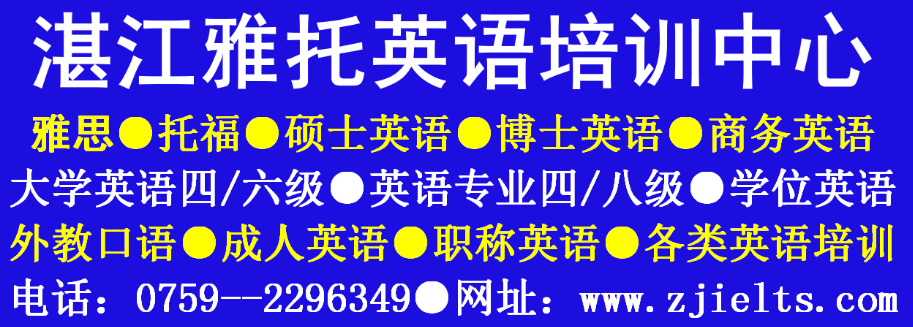大学英语四级阅读Section B讲解与分析【3】
Section B
Directions: In this section, you are going to read a passage with ten statements attached to it. Each statement contains information given in one of the paragraphs. Identify the paragraph from which the information is derived. You may choose a paragraph more than once. Each paragraph is marked with a letter. Answer the questions by marking the corresponding letter on Answer Sheet 2.
Team spirit
[A] Teams have become the basic building blocks of organizations. Recruitment advertisements routinely call for “team players”. Business schools grade their students in part on their performance in group projects. Office managers knock down walls to encourage team building. Teams are as old as civilization, of course: even Jesus had 12 co-workers. 【41】But a new report by Deloitte, “Global Human Capital Trends”, based on a survey of more than 7,000 executives in over 130 countries, suggests that the fashion for teamwork has reached a new high. Almost half of those surveyed said their companies were either in the middle of restructuring or about to embark on (开始)it; and for the most part, restructuring meant putting more emphasis on teams.
[B] Companies are abandoning conventional functional departments and organising employees into cross-disciplinary teams that focus on particular products, problems or customers. These teams are gaining more power to run their own affairs. They are also spending more time working with each other rather than reporting upwards. 【38】Deloitte argues that a new organisational form is on the rise: a network of teams is replacing the conventional hierarchy (等级体制).
[C] The fashion for teams is driven by a sense that the old way of organising people is too rigid for both the modem marketplace and the expectations of employees. Technological innovation places greater value on agility (灵活性).John Chambers, chairman of Cisco Systems Inc., a worldwide leader in electronics products, says that “we compete against market transitions (过渡),not competitors. 【45】Product transitions used to take five or seven years; now they take one or two. ” Digital technology also makes it easier for people to coordinate their activities without resorting to hierarchy. The “millennials” (千禧一代) who will soon make up half the workforce in rich countries were raised from nursery school onwards to work in groups.
[D] The fashion for teams is also spreading from the usual corporate suspects (such as GE and IBM) to some more unusual ones. The Cleveland Clinic, a hospital operator, has reorganised its medical staff into teams to focus on particular treatment areas; consultants, nurses and others collaborate closely instead of being separated by speciality (专业)and rank. The US Army has gone the same way. In his book, “Team of Teams' General Stanley McChrystal describes how the army’s hierarchical structure hindered its operations during the early stages of the Iraq war. 【37】His solution was to learn something from the insurgents it was fighting: decentralise authority to self-organising teams.
[E] A good rule of thumb is that as soon as generals and hospital administrators jump on a management bandwagon, it is time to ask questions. Leigh Thompson of Kellogg School of Management in Illinois warns that, ‘Teams are not always the answer—teams may provide insight, creativity and knowledge in a way that a person working independently cannot; but teamwork may also lead to confusion, delay and poor decision-making.”【43】 The late Richard Hackman of Harvard University once argued, “I have no question that when you have a team, the possibility exists that it will generate magic, producing something extraordinary... But don’t count on it.”
[F] Hackman (who died in 2013) noted that teams are hampered by problems of co-ordination and motivation that chip away at the benefits of collaboration. High-flyers forced to work in teams may be undervalued and free-riders empowered. Groupthink may be unavoidable. In a study of 120 teams of senior executives, he discovered that less than 10% of their supposed members agreed on who exactly was on the team. 【42】If it is hard enough to define a team’s membership, agreeing on its purpose is harder still.
[G] Profound changes in the workforce are making teams trickier to manage. 【40】Teams work best if their members have a strong common culture. This is hard to achieve when, as is now the case in many big firms, a large proportion of staff are temporary contractors. Teamwork improves with time: America’s National Transportation Safety Board found that 73% of the incidents in its civil-aviation database occurred on a crew’s first day of flying together. However, as Amy Edmondson of Harvard points out, organisations increasingly use “team” as a verb rather than a noun: they form teams for specific purposes and then quickly disband them.
[H] The least that can be concluded from this research is that companies need to think harder about managing teams. They need to rid their minds of sentimentalism (感情用事):【36】the most successful teams have leaders who are able to set an overall direction and take immediate action. They need to keep teams small and focused: giving in to pressure to be more “inclusive” is a guarantee of dysfunction. Jeff Bezos, Amazon’s boss, says that “If I see more than two pizzas for lunch, the team is too big.” They need to immunize teams against group-think: Hackman argued that the best ones contain “deviants” (离经叛道者)who are willing to do something that maybe upsetting to others.
[I] A new study of 12,000 workers in 17 countries by Steelcase, a furniture-maker which also does consulting, 【44】finds that the best way to ensure employees are “engaged” is to give them more control over where and how they do their work―which may mean liberating them from having to do everything in collaboration with others.
[J] However, organisations need to learn something bigger than how to manage teams better: they need to be in the habit of asking themselves whether teams are the best tools for the job. Teambuilding skills are in short supply: Deloitte reports that only 12% of the executives they contacted feel they understand the way people work together in networks and only 21% feel confident in their ability to build cross-functional teams. 【39】Loosely managed teams can become hotbeds of distraction―employees routinely complain that they can’t get their work done because they are forced to spend too much time in meetings or compelled to work in noisy offices. Even in the age of open-plan offices and social networks some work is best left to the individual.
解析: 做段落匹配题,由于时间限制,需要快速阅读,大眼一看,就得得出答案,否则将影响后后面的写作。
第一步:仔细阅读给出的选项36-45,
第二步:带着问题读一段文章,结合给出的选项做出选择,找不到的先放到一边,接着读下一段。
第三步:完成第二步后将剩余的没有匹配的题目
第四步:如果有时间的话可以检测一下,看有没有错误
【杀掉拦路虎】
1. Recruitment [rɪ'kru:tmənt]
n.征募新兵;补充;募集
2. routinely [ru:'ti:nlɪ]
adv.例行公事地;常规地,惯常地;老一套地
3. civilization [ˌsivilaiˈzeiʃən]
n. 文明,文化;开化,教化;修养;文明社会
4. executive [iɡˈzekjutiv]
n. 总经理;行政部门;[计算机]执行指令;
adj. 执行的;管理的;政府部门的
5. restructuring [ˌri:ˈstrʌktʃərɪŋ]
v.重建,改建,重组( restructure的现在分词 )
6. conventional [kənˈvenʃənl]
adj. 传统的;习用的,平常的;依照惯例的;约定的
7. functional [ˈfʌŋkʃənl]
adj.功能的;[数]函数的;有多种用途的;机能性
8. employee [ˌemplɔiˈi:]
n. 雇工,雇员,职工
9. disciplinary [ˈdɪsəplɪnəri]
adj.纪律的;训练的;惩罚的
10. affair [əˈfɛə]
n. 事情,事件;事务;个人的事,私事;风流韵事
11. innovation [ˌɪnəuˈveiʃən]
n. 改革,创新;新观念;新发明;新设施
12. Digital [ˈdidʒitəl]
adj. 数字的;数据的;手指的;指状的;
n. 手指;(钢琴等的)琴键;数字
13. hierarchy [ˈhaɪərɑ:ki]
n.[计]分层,层次;等级制度;统治集团;天使的级别或等级
14. nursery school [ˈnə:səri sku:l]
n.幼儿园;托儿所
15. onwards [ˈɒnwədz]
adv.向前
16. Decentralisation [ˌdi:sentrəlaɪ'zeɪʃən]
n.分散
17. authority [ɔ:ˈθɔriti]
n. 权威;权力;学术权威;[复数]当权者
18. military [ˈmilitəri]
adj. 军事的;军用的;讨厌的;好战的;
n. 军人;军队;武装力量
19. corporate [ˈkɔ:pərət]
adj.法人的,团体的,社团的;公司的,总体国家的;〈古〉团结的;共同的,全体的
20. Clinic [ˈklinik]
n. 诊所,门诊部;特殊病例分析;临床讲授;临床实习课
21. consultant [kənˈsʌltənt]
n.(受人咨询的)顾问;会诊医生,(顾问)医生;求教者,(与人)商议者,征求意见者,查阅者,咨询者
22. collaborate [kəˈlæbəˌreɪt]
vi. 合作,协作;(国家间的)协调,提携;勾结,通敌
23. speciality [ˌspeʃiˈæliti]
n. 专业,专长;特性;特制品;英〉同specialty
24. hierarchical structure [ˌhaiəˈrɑ:kikəl ˈstrʌktʃə]
层次结构,分级结构;递阶结构
25. hinder [ˈhɪndə(r)]
vt.& vi.阻碍,妨碍;成为阻碍
adj.后面的,后方的
26. insurgent [ɪnˈsɜ:dʒənt]
adj.起义的,叛乱的,造反的
n.起义者,叛乱者,造反者
27. decentralise [di:'sentrəlaɪz]
vt.权力下放,将(权力等)自中央政府转到地方政府;将(工业、工人等)自集中点分散到较大的区域内
n.分散
28. thumb [θʌm]
n. 拇指;(手套的)拇指部份;
vi. 翘起拇指请求搭乘(过路汽车),示意请求搭便车;翻阅;
vt. 翻阅;作搭车手势;用拇指翻脏[翻坏](书页等)
29. bandwagon [ˈbændwægən]
n.时尚,浪潮;[音乐]乐队彩车;[非正式用语] 引导车;[非正式用语]潮流
30. insight [ˈinsait]
n. 洞察力,洞悉;直觉,眼光;领悟;顿悟
31. generate [ˈdʒenəreit]
vt. 形成,造成;产生物理反应;产生(后代);引起
32. motivation [ˌməʊtɪ'veɪʃn]
n.动机;动力;诱因
33. chip away [tʃip əˈwei]
拆掉,削掉,铲除;凿[敲]下碎片;蚕食;逐步瓦解
34. collaboration [kəˌlæbəˈreɪʃn]
n.合作,协作;通敌,勾结
35. High-flyer [hai ˈflaiə]
n.抱负极高的人,有野心的人
36. empower [ɪmˈpaʊə(r)]
vt.授权;准许;使能够;使控制局势
37. Profound [prəˈfaund]
adj. 深厚的;意义深远的;严重的;知识渊博的;
n. 〈诗〉深海,大洋;深渊;(灵魂)深处
38. tricky [ˈtrɪki]
adj.狡猾的;(形势、工作等)复杂的;机警的;微妙的
39. proportion [prəˈpɔ:ʃən]
n. 比,比率;[数学]比例(法);面积;相称,平衡;
vt. 使成比例;使相称;使均衡
40. contractor [kənˈtræktə(r)]
n.订约人,承包人;收缩物
41. incident [ ˈinsidənt]
n. 事件,事变;小插曲;敌对行动;骚乱;
adj. [法]附带的;[光]入射的;易有的,附随的
42. disband [dɪsˈbænd]
vt.(使)解散,散伙;解体;遣散
vi.解散;遣散
43. rid [rid]
vt. 使摆脱,解除,免除
44. inclusive [inˈklu:siv]
adj. 包括的,包罗广泛的;包括…的;一切开支包括在内的;(语言使用上)不分男女的
45. dysfunction [dɪs'fʌŋkʃn]
n.机能障碍,机能失调
46. immunize [ˈɪmjunaɪz]
vt.使免疫;使免除
47. engaged [ɪnˈgeɪdʒd]
adj.(指厕所等)有人用的;已订婚的;(指电话)占线的;忙碌的
v.与某人订婚;保证,约定;从事( engage的过去式和过去分词);吸引或引起(注意、兴趣等)
48. hotbed [ˈhɒtbed]
n.(坏事、暴力等的)温床
49. Loosely [ˈlu:slɪ]
adv. 松散的,蓬松的;轻易,轻松地,随手地,随意地;大意,粗略地,不严格的;无力地,软绵绵地
50. compelled [kəm'peld]
v.强迫,使不得不( compel的过去式和过去分词 );引起反应
- Successful team leaders know exactly where the team should go and are able to take prompt action.
【答案】H
【解析】关键词leaders,根据【36】the most successful teams have leaders who are able to set an overall direction and take immediate action. 可以定位到H段 因此本题的正确答案为H选项
- Decentralisation of authority was also found to be more effective in military operations.
【答案】D
【解析】关键词Decentralisation of authority,由【37】His solution was to learn something from the insurgents it was fighting: decentralise authority to self-organising teams.可以定位到D段因此本题的正确答案为D选项
- In many companies, the conventional form of organisation is giving way to a network of teams.
【答案】B
【解析】关键词为a network of teams,【38】Deloitte argues that a new organisational form is on the rise: a network of teams is replacing the conventional hierarchy (等级体制).因此本题的正确答案为B选项
- Members of poorly managed teams are easily distracted from their work.
【答案】J
【解析】根据【39】Loosely managed teams can become hotbeds of distraction可以定位到J段,红线部分是问题的同义转换,因此本题的正确答案为J选项
- Teamwork is most effective when team members share the same culture.
【答案】G
【解析】关键词为culture根据 【40】Teams work best if their members have a strong common culture. 可以定位到G段,因此本题的正确答案为G选项
- According to a report by Deloitte, teamwork is becoming increasingly popular among companies.
【答案】A
【解析】Deloitte为关键词,通读第一段【41】But a new report by Deloitte, “Global Human Capital Trends”, based on a survey of more than 7,000 executives in over 130 countries, suggests that the fashion for teamwork has reached a new high. ,符合句意,因此本题的正确答案为A选项
- Some team members find it hard to agree on questions like membership and the team’s purpose.
【答案】F
【解析】关键词membership根据 【42】If it is hard enough to define a team’s membership, agreeing on its purpose is harder still. 可以定位到C段,因此本题的正确答案为F选项
- Some scholars think teamwork may not always be reliable, despite its potential to work wonders.
【答案】E
【解析】【43】 The late Richard Hackman of Harvard University once argued, “I have no question that when you have a team, the possibility exists that it will generate magic, producing something extraordinary... But don’t count on it.”,是上述的同义转换,因此本题的正确答案为E选项
- To ensure employees’ commitment, it is advisable to give them more flexibility as to where and how they work.
【答案】I
【解析】根据【44】finds that the best way to ensure employees are “engaged” is to give them more control over where and how they do their work 可以定位到I段,因此本题的正确答案为I选项
- Product transitions take much less time now than in the past.
【答案】C
【解析】关键词Product transitions, 【45】Product transitions used to take five or seven years; now they take one or two. ” 因此本题的正确答案为C选项












